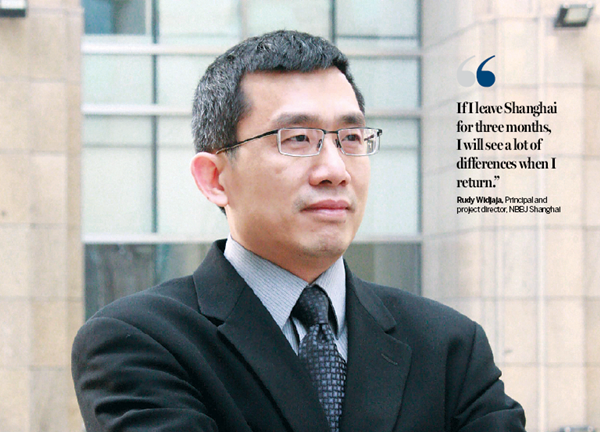Architect of change
 |
|
As an architect, Rudy Widjaja finds China very exciting and the best place to be. Provided to China Daily |
Indonesian transforming China's healthcare industry by helping to build a world-class hospital in Shanghai
Many architects dream of designing projects that shape a city's skyline in an iconic way. But Rudy Widjaja's ambitions are a tad more pragmatic.
The 55-year-old is principal and project director at architecture and design practice NBBJ Shanghai. Of late, he has made it his mission to contribute to China's healthcare.
"A few years ago, the government opened the market and welcomed foreign investment. It has given us the chance to design better quality hospitals," Widjaja said.
To be launched by the end of the year is the 246-bed first phase of the privately-owned, world-standard Shanghai Jiahui International Hospital.
It is envisioned as a "hospital in a garden", where natural light and greenery will be introduced. At the heart of the design is a central courtyard styled after a park and visible from the lower floors.
When completed, it will be one of the best international hospitals in Shanghai and maybe even China, Widjaja said.
By the looks of it, he might just succeed, given his strong track record.
Before moving to Shanghai in 2007 to take on his current role, he worked on the design for three hospitals and one health and research institute in Taiwan.
NBBJ, based in Seattle in the United States, is well known for its healthcare design, with 50 percent of its revenue coming from projects in the sector.
"Now that the government has opened up the market in China, investors will come in and offer better quality healthcare — something which consumers are also demanding," Widjaja said.
"Many affluent Chinese go overseas for their medical needs because they get better service. The government understands this and wants to change it. I am confident that they will make it right."
Healthcare aside, Widjaja is also well-versed in designing office campuses, particularly for tech companies.
These include the headquarters of internet giant Tencent in Shenzhen, in South China's Guangdong province, and those of appliance retailer Suning in Nanjing, in the eastern Jiangsu province.
It was also announced earlier this year that NBBJ will be designing Alibaba's new Hangzhou headquarters, in East China's Zhejiang province, to be completed by 2019.
"Although NBBJ is headquartered in the US, we cannot just dump our practices from there into China. Our designs need to be sensitive to the culture and context," Widjaja said.
Widjaja recalls the 270,000-square-meter, twin-tower Tencent project with fondness, but admitted it was very challenging to think about pedestrian flow. At lunch times, 12,000 workers all head to the canteen simultaneously.
"The volume and scale here is massive," he said. "To add to that, each project takes about two to three years to complete. We need to make sure that by the time it is ready, the technology in the building is up-to-date and efficient, so provisions have to be made."
This is why at NBBJ, the concept of ‘change design' is very important.
"The world is (changing) at a rapid pace. We need to understand that to do a better job in design, we need to know the client's business before we can design a facility that they will like.
"Also, the design that we propose needs to help improve productivity, efficiency and creativity. This is the way we see design."
One of his firm's key advantages is the integration of neuroscience research into its designs to boost well-being and cognitive performance. Specifically, NBBJ subscribes to Seattle-based molecular biologist John Medina's findings that the human brain is most productive when it has access to nature.
Citing the Alibaba headquarters project that NBBJ clinched in March, Widjaja said: "Their existing buildings don't have natural light and landscaping. In our proposal, we put an emphasis on that."
Each employee's workspace will be under a minute from green spaces.
Other green features include having all workstations close to windows overlooking green spaces, and windows that open to let in fresh air.
"One of NBBJ's strengths is our ability to integrate different disciplines — urban design, signage, interiors, landscaping and architecture. We therefore don't need to hire external consultants and risk having an unintegrated solution," Widjaja said.
Born in Medan, Indonesia, Widjaja went to Taiwan to study at the age of 14. "I was glad to go there because it was eye-opening." He explained he was sent there due to the relatively "poor" education standard in his birthplace.
He remained in Taiwan for 12 years before heading to the US for his master's degree in architecture. Along the way, he picked up Mandarin and discovered he had a talent for painting.
Upon graduating from high school, he wanted to go to art school. "My father advised me not to do that because then I'll be poor for the rest of my life," he said with a laugh.
So he settled on the next best option — architecture — banking on the fact that he could draw, and appreciated design and beautiful spaces.
The decision to head to Ohio in the US to further his studies was because many of his peers were doing the same. "I followed the flow."
What he did not anticipate was such a long stay in the US. After completing his master's degree, he joined NBBJ in 1989 and has been with the firm ever since.
"I thought I'd work for three years in the US, then return to Asia. But this was the late 1980s and Asia was going through a financial crisis, so I just continued working there," he said.
However, one of the partners was an Austrian who was passionate about taking on projects outside the US, particularly in Europe. The firm also had a partner who liked to work in Asia.
With this Indonesian roots, Mandarin competency and knowledge of Chinese culture, Widjaja was naturally assigned to projects in his home continent.
"I loved it because it was part of my original goal to contribute to and build a better environment in Asia.
"It was also challenging, because I had to travel there eight to 10 times a year, staying for up to three weeks each time. My body clock was all messed up!"
In 2007 came the opportunity to head up the Shanghai office, so he packed his bags, uprooted his family, and shifted to China.
"There were 15 people when I joined. After I came, we grew the team to 50-plus people."
It is probably rare today to find individuals like Widjaja who have committed their entire careers to one organization — in his case, a span of 28 years.
"I like the culture because it is a very flat organization," he said. "There are no private offices, everything is very accessible and communication is very open.
"There is no strict hierarchy and we are very collaborative. We will use the best idea regardless of the person's experience or rank."
He said he has had the time of his life living and working in China for the past 10 years.
"If I leave Shanghai for three months, I will see a lot of differences when I return — not just the buildings but also the infrastructure. But when I return to Ohio after a few years, nothing changes."
As an architect, Widjaja finds China very exciting and the best place to be, with so many opportunities, and he appreciates the open-mindedness of clients and the government.
















